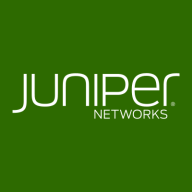


In the firewall industry, Juniper SRX Series and Netgate pfSense are significant contenders. Juniper SRX Series has an advantage due to its robust enterprise features, while Netgate pfSense benefits from open-source flexibility and low costs.
Features: Juniper SRX Series Firewall is recognized for its deep packet inspection, IPSec VPN, and application visibility and control, highlighting its enterprise-level routing capabilities. Its scalability and interoperability make it suitable for complex environments. In contrast, Netgate pfSense offers key features like VPN, load balancing, and content filtering, appealing to budget-conscious small and medium businesses through its open-source model and absence of licensing fees.
Room for Improvement: Juniper SRX could enhance its user interface and third-party integration capabilities, with improvements suggested in administration and next-generation security features. Netgate pfSense would benefit from enhanced central management for better handling of multiple devices, improved package management, and a more intuitive user interface for smoother integrations with third-party security features.
Ease of Deployment and Customer Service: Juniper SRX provides robust on-premises deployment with commendable customer service, albeit with a noted learning curve. Netgate pfSense is praised for easy deployment across various environments and is noted for flexibility in hardware setups, with generally helpful customer service.
Pricing and ROI: Juniper SRX is viewed as a mid-range option with competitive hardware pricing but costly support. It sits between high-end solutions like Palo Alto and more affordable ones like Fortinet. Netgate pfSense offers a cost-effective alternative, particularly with its open-source model, providing a high ROI for small and medium businesses due to its low maintenance and absence of licensing fees.
Clients are now comfortable and not wasting productive hours on IT support.
The automation part is giving us a cost benefit and speed; we can react faster.
It's a very useful tool to mitigate and protect your enterprise.
If they can save their data from attackers then it would save them at least two days of not working plus the cost of recovery, which would be much more than the cost of the system and maintenance.
Since the memory leak fixes, it's been incredibly stable and requires minimal maintenance.
In four years of using it, that payment of 189 dollars per year has already paid off.
They offer very accurate solutions.
The quick resolution of issues with Fortinet FortiGate is due to the support of the company and the fact that the equipment is easy to work with.
I would rate the technical support for Fortinet FortiGate a ten out of ten.
Technical support is very good.
When I provide detailed information about the problem, they've been able to reply quickly with a solution or go research the problem and get back to us quickly with a fix.
They are highly responsive.
I couldn't imagine having better support.
They scale up really well from smaller models like the FortiGate 40 and 50 to bigger sites with the FortiGate 100 for more throughput - up to enterprise datacenters.
The variation comes in terms of the interfaces and throughputs, but from a security perspective, you get the same benefit, irrespective of whether you have an entry-level unit or an enterprise.
We determine sizing based on multiple factors: number of users, available links, traffic types, server count, services in use, and whether services will be published.
If I put things into a certain context and say that we have a network that has around 100 people, then you don't put up a device that can manage 100 people. Instead, you need to get a device that can manage 150 to 200 people, and then you can create room for growth.
I don't think Netgate pfSense can offer much scalability for big enterprises.
Even with a jump from a 50 megabit to a 500 megabit internet connection and approximately 65 active VPN clients, our firewall operates smoothly without any strain.
We're experiencing 99.999% availability consistently.
I would rate the stability of Fortinet FortiGate a ten out of ten.
Currently, we are experiencing a general outage of one of the main internet service providers of the Dominican Republic, and we have not been impacted in our operations because with SD-WAN, we have another internet service provider and we are working with the second WAN connection without any disruption.
The solution has absolutely high stability.
I rate the solution's stability a ten out of ten.
I've noticed a substantial improvement in stability and ease of use for upgrades and patching over the past year or two.
When I replace consumer routers with pfSense for small businesses with two or three employees, they are often amazed to discover the router can run for a year without a reboot.
Investing in a solution that can accommodate such growth would be more cost-effective than repeatedly purchasing new hardware.
While Fortinet claims to offer a comprehensive network solution, it falls short in addressing computer application issues, particularly server security.
When considering Sophos XG, which we also use, the logging and reporting functionality is notably more efficient.
With a better user interface and graphical interface, the Juniper SRX Series Firewall could be a superior solution compared to what it is now.
With my extensive experience with the Juniper SRX Series Firewall, the robustness of the SD-Cloud or Security Director interface and overall functionality needs to be improved to compete with leading firewall solutions.
There is some trade-off between having a certain level of security and maintaining acceptable performance.
If I need to go between different VLANs, I have VLAN 19.1 and VLAN 19.2, and I strictly use Netgate pfSense, but it doesn't route very efficiently and works quite slowly.
They should support the idea of configuration management as code from source code and provide a more robust API for managing the pfSense configuration.
Last year, I renewed the support for three years, which can sometimes be expensive but depends on the security benefits and how it helps us.
It offers cost savings as it is generally cheaper than the competition.
It is about 20% cheaper.
The Juniper SRX Series Firewall is affordable and cost-effective.
The price of setup is approximately €500 to €800, which also includes the initial monitoring.
You can acquire a decent embedded PC for around a hundred dollars and install pfSense on it, effectively creating a robust firewall solution.
The product is free of cost.
In terms of security, we have not experienced any security flaws or loopholes, and it has proven to be quite stable.
FortiGate has helped reduce the risk of cyberattacks that might disrupt our client's production.
These features help reduce our downtime, manage the ISPs, and deploy SLAs for all the website traffic.
The routing, Layer 2, 3, 4 solutions in the network layers are valuable features.
Juniper SRX Series Firewall helps in terms of network security for my customers by protecting end-users from any form of cyber attack or threat, with a good database that updates and pushes out signatures to defend against threats.
We have multiple VLANs, and with assistance, it was easy to get everything set up and running in our organization the way we needed it to.
We had downtime before pfSense. We've never gone down using the solution.
It is very stable, and it works very well.
| Product | Market Share (%) |
|---|---|
| Fortinet FortiGate | 20.4% |
| Netgate pfSense | 10.8% |
| Juniper SRX Series Firewall | 1.7% |
| Other | 67.1% |



| Company Size | Count |
|---|---|
| Small Business | 350 |
| Midsize Enterprise | 130 |
| Large Enterprise | 187 |
| Company Size | Count |
|---|---|
| Small Business | 45 |
| Midsize Enterprise | 20 |
| Large Enterprise | 32 |
| Company Size | Count |
|---|---|
| Small Business | 166 |
| Midsize Enterprise | 33 |
| Large Enterprise | 28 |
Fortinet FortiGate excels in providing integrated VPN, firewalling, and Unified Threat Management (UTM) with centralized management and high availability. It supports remote access and comprehensive threat protection, making it a preferred choice for securing networks.
Fortinet FortiGate offers a robust security platform with features such as strong intrusion prevention, application control, and web filtering. Its integration with Active Directory and SD-WAN functionality provides scalable solutions for large networks. Users appreciate its ease of use through centralized management interfaces, ensuring robust security with flexible configurations. However, FortiGate could enhance its graphical interface and technical support responsiveness, address firmware bugs and costly licensing, improve logging, integrate better with third-party tools, and strengthen scalability and memory for log storage. Complexity in configuration and the need for intuitive features are noted challenges, and there's a demand for advanced security, zero-trust capabilities, and AI integration.
What are the key features of Fortinet FortiGate?Fortinet FortiGate is widely implemented across industries like education, finance, and government. Companies use it for firewall protection, VPN, and SD-WAN capabilities, ensuring secure perimeter and data center security. It facilitates remote access management and traffic routing optimization, offering reliable security and connectivity solutions.
Juniper SRX is a next-generation security solution that enables users to expand and secure their networks without incurring heavy costs or sacrificing performance.
Benefits of Juniper SRX
Some of the benefits of using Juniper SRX include:
Reviews from Real Users
Juniper SRX stands out among their competitors for a number of reasons. Two major ones are their central management capabilities and the robustness of their suite of security features. Juniper SRX is designed to make it easy for users to take control of their network’s security. From one location, administrators can manage all aspects of their infrastructure’s security. The many features that it offers allows users to tailor their security to meet their specific needs.
Shashidhara N., director of technology solutions & services at Connectivity IT Services Private Limited, writes, “On the SRX box, it has what I call a one model concept for security. I work especially with hybrid environments. With an SRX we have a single management dashboard. We can manage the internal framework easily with the centralized management component. You can work with threat prevention, you can work with integration, you can work with traffic management. Another good part about SRX is that you have opportunities for automation. Another thing that is very good is that all the operating systems for all Juniper boxes are the same. You do not work on different operating systems using different boxes.”
Pradip J., the owner of Shree Atharva Sales Corporation, writes, “It is a complete security bundle. The cloud-based Sky Advanced Threat Prevention feature is very valuable. I am 100% satisfied with the performance of the Juniper firewall. It has a very good throughput. It works very fine. We use our firewall as a site-to-site VPN or Software-Defined Wide Area Network (SD-WAN). In both cases, it has a very good and optimum performance.Their service support is very good in India. I get really good support from the Juniper team."
Netgate pfSense is widely leveraged by organizations for its comprehensive capabilities in firewalls, VPN servers, and bandwidth management. It suits LAN, WAN, and DMZ networks, offering secure, scalable, and efficient networking solutions.
Netgate pfSense stands out in diverse environments with its enterprise-grade features and cost-effective operations compared to competitors like Cisco. Deployed as an edge device, it optimizes routing, ad-blocking, content filtering, and traffic shaping. Users benefit from its versatile configurations, robust firewall protection, VPN functionality, and ISP load balancing. The open-source nature allows for extensive customization, integrating plugins like Snort and pfBlockerNG, and compatibility with third-party tools enhances its utility. The intuitive GUI combined with detailed logging and centralized management fortifies network security.
What features define Netgate pfSense?
What benefits should be considered for ROI?
Organizations in industries such as finance, healthcare, and education find Netgate pfSense integral due to its advanced security features and cost benefits. Its scalable architecture and strong VPN support are crucial for industries requiring stringent data protection and reliable remote access. The adaptability of pfSense makes it suitable for dynamic environments seeking comprehensive, secure networking solutions.
We monitor all Firewalls reviews to prevent fraudulent reviews and keep review quality high. We do not post reviews by company employees or direct competitors. We validate each review for authenticity via cross-reference with LinkedIn, and personal follow-up with the reviewer when necessary.